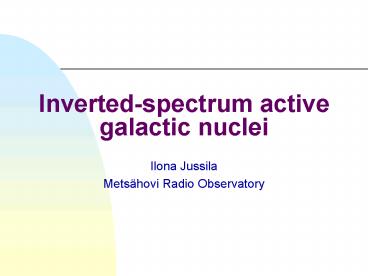Invertedspectrum active galactic nuclei - PowerPoint PPT Presentation
1 / 14
Title:
Invertedspectrum active galactic nuclei
Description:
EGRET detections of AGNs. 66 high-confidence identifications of AGNs ... But not all bright and variable AGNs were detected with EGRET... Ilona Jussila ... – PowerPoint PPT presentation
Number of Views:21
Avg rating:3.0/5.0
Title: Invertedspectrum active galactic nuclei
1
Inverted-spectrum active galactic nuclei
- Ilona Jussila
- Metsähovi Radio Observatory
2
Normal AGNs
- Continuum spectra falling at radio frequencies
- Size Mpc
3
Inverted-spectrum sources
- Gigahertz-peaked spectrum (GPS) sources
- Turnover 1 GHz
- Size 1kpc
- even 10 of all AGN (ODea, 1998)
- very little variability
- Compact steep-spectrum (CSS) sources
- Turnover 100 MHz
- Size lt 15 kpc
- 15 - 30 of all AGN (Fanti et al., 1990)
4
Unification of inverted-spectrum AGN
- CSS and GPS sources related?
- Small size and spectral shape should be explained
- Youth scenario (Mutel and Phillips, 1988)
- Frustration scenario (Gopal-Krishna and Wiita,
1991) - Recurrent activity (Baum et al. 1990)
5
High-peaking GPS sources
- High-peaking GPS sources
- Peak frequency gt10GHz, even up to 100GHz during
bursts - Variable!? (Tornikoski et al., 2001, Jussila
2002) - Important for Planck Surveyor
6
The study
- Original goal
- to identify new high-peaking GPS sources
- to study the variability of the known ones
- Sample
- Successful observations for 41 sources
- 13 new candidates
- 28 known inverted-spectrum sources
- Morphologically quasars, BL Lacs and radio
galaxies - Monitored in Metsähovi since autumn 2001_at_37 GHz
- Some observations at SEST in Chile
- Additional data from literature
7
The results so far...
- New candidates
- 7 / 13 sources turned out to be flat spectrum
sources with inverted spectrum during the bursts
(IDB) - 6 / 13 were inverted but very variable
- No classical high-peaking GPS sources found!
8
The results so far...
- Known GPS sources
- Half of the bona fide GPS sources turned out to
be flat-spectrum sources with inverted spectrum
during the bursts (IDB) - gt The classification has been done with too
sparse data
9
The results so far...
- Known GPS sources
- Many of the remaining genuine GPS sources
exhibited variability ?Original definition! - gt The classification of the sources has been
done with too sparse data! - gt The concept of GPS sources should be
re-examined
10
The results so far
- Most of the rest genuine GPS sources had so
sparse data that the interpretation is not
reliable - gt more data needed to reveal the multi-epoch
spectra - It is possible that of all GPS sources a
considerable proportion will lose their
GPS-classification
11
Questions
- How many of the GPS sources are variable? Really
inverted during the quiescent phases? High
peaking? - Is there evidence for a totally new group IDB
(Inverted During Bursts) sources with flat
quiescent spectrum and very inverted flare
spectrum?
12
The Future
- Monitoring continues at Metsähovi
- gt Multi-epoch data on high frequency variability
of the sources - gt The sample extended to include also
galaxy-type GPS sources will they exhibit
variability too? - Observations with other telescopes
- Development of variability models continues at
Metsähovi - Statistical analysis of the IDB candidates
13
EGRET detections of AGNs
- 66 high-confidence identifications of AGNs
- 27 lower-confidence identifications of AGNs
- (Hartman et al., 1999)
- Practically all are bright and variable in the
millimeter domain (Tornikoski et al., 2002) - But not all bright and variable AGNs were
detected with EGRET...
14
Gamma-ray activity
- The most probable AGN to be detected in
gamma-rays is a source with.. - an ongoing and still rising high-frequency radio
flare - an inverted/flat spectrum up to 100 GHz during
the active state (Tornikoski et al., 2002) - gt IDBs?!
- Radio observations as a ToO tool for gamma
instruments - The beginning of a radio flare, the formation of
a new radio shock seems to correlate with the
gamma activity































